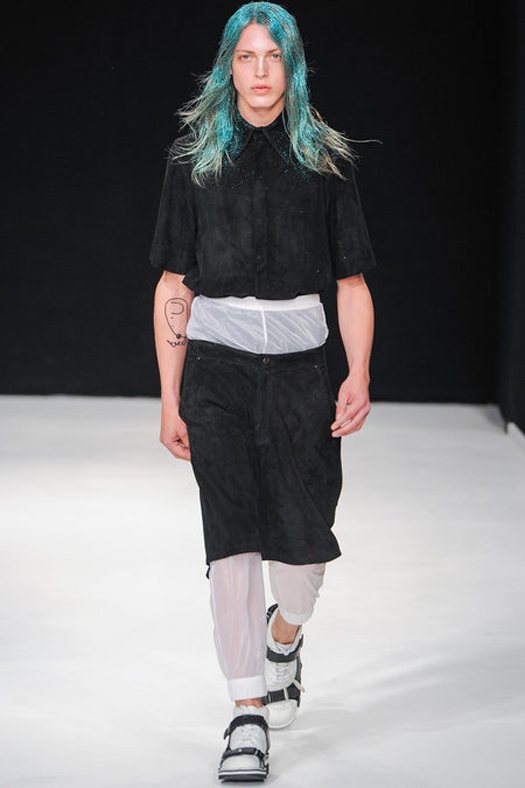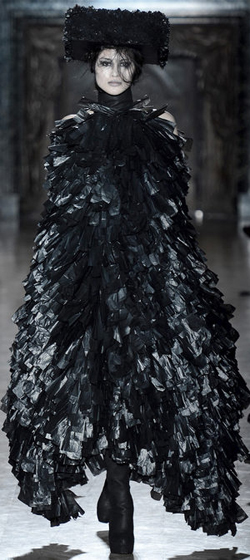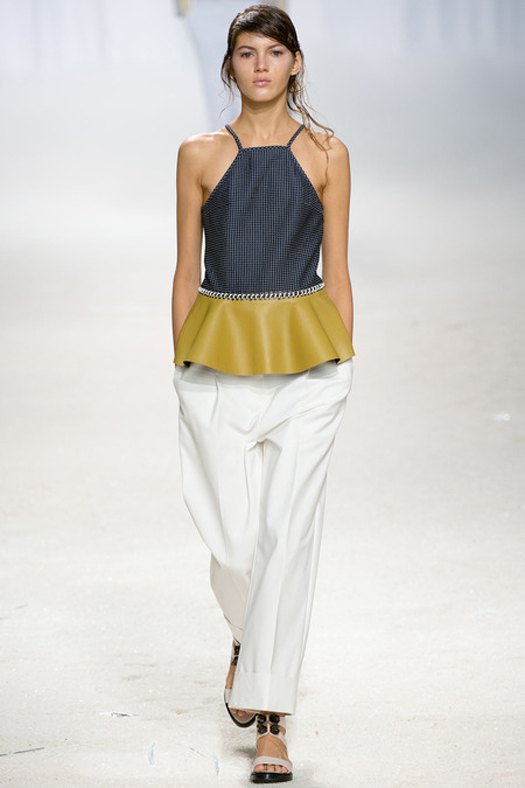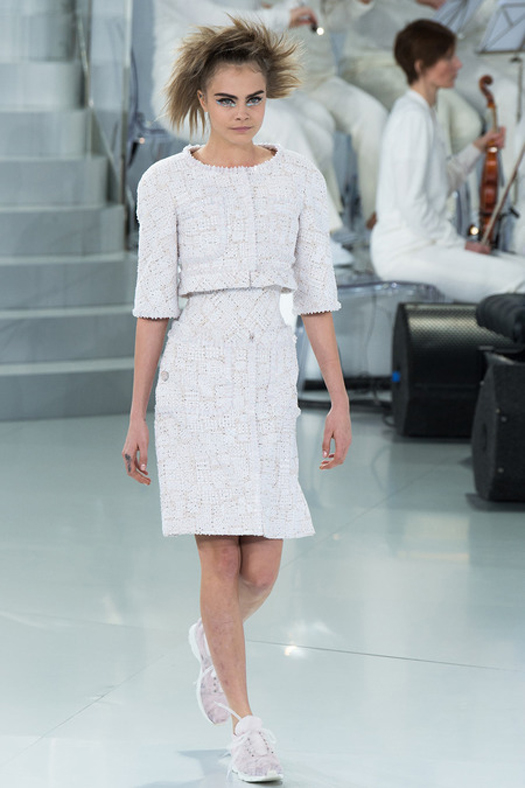Depending on how much you like beer and pies, the waistline should be the narrowest part of your torso, officially positioned horizontally between the hips and ribs. Not many people know this because there are so many design lines calling themselves a waistline. This would be totally fine, except who knows how to wear any of them?

Waistline, but which one? Look 8, Christopher Shannon s/s14 menswear. Source: Style.com
Your body’s waist is higher than you think, for example high-waisted jeans in 2014 are considered to rise very high up the body, when actually they’re sitting on your waistline. Design has evolved encouraging us to play with this line which can be an exciting and liberating experience. Visually structuring your look, exposing flesh, drawing attention to other garments, or directing the eye to parts of the body like the waist itself, the chest and hips. The waistline can guide the eye further out, for when dressed you become a 3 dimensional artwork of colours, shapes and lines – all dependent on each other.
An example of a garment with a really high waistline might be buttoned up breeches or leggings that stretch all the way up to the chest. Or it could become a design line within the garment as with an empire line dress, as the waistline becomes a seam sitting just below the bust. At the bottom end, literally, are low-waisted boxers or briefs that cut across the middle of the hip bones and around the buttocks. Similarly jeans, trousers and skirts, often do more than tease as the waistline is cut or styled to sit very low or very very low… Alternatively, a flapper dress gives the illusion of having no waist at all and a kimono, builds layers of silk on top of layers of silk with belt after belt, all used to flatten out your curves as the body becomes one with the kimono, cylindrical and firm like the trunk of a tree. Options for the waistline are endless, so you can begin to see why this area has become such a confused landscape, the midriff – set adrift!
It’s not your fault. This is an example of fashion losing itself at the dead-end of postmodernism. We have had a lot of fun getting here, but now we are left with a culture of anything goes, without guidelines to say actually ‘anything’ doesn’t go and editing is a good thing! It is important to know your body shape, skin tone and basic qualities of a garment. But fashion doesn’t want consumers to be conscious, as long as people are buying goods. It doesn’t mind if you walk around looking like mashed potato that’s been flicked at a wall.
Fashion pretends to care, when actually it now operates almost wholly on a superficial level of mirrors and lights style trickery. Instructions are snapped at us to keep us distracted “High waist, low waist, middle waist, no waist, oversized waist, pants showing, wear with a cropped top, a skirt with a yoke, add a pelmet, have a dungaree flap with pockets attached and make it a dropped crotch with a loose waist then wear them back-to-front” On it goes… To add to this barrage of orders, advertising increasingly uses digitally enhanced images of clothes that have probably been pinned at the back, worn on a taller than average (or digitally stretched), slimmer than average (or squeezed digitally), younger than most (or made to look even younger digitally) model. Who could and has, more than once, walked down the runway wearing plastic bags with the front row clapping in awe.[ref] Look 47, Gareth Pugh a/w ready-to-wear. Source: Style.com[/ref] Whilst creatively this may be inspiring, fashion does little to encourage us to connect with our individual body shape or even face the REALITY of clothing, that needs to look good on, and be practical too.
Look 47, Gareth Pugh a/w ready-to-wear. Source: Style.com[/ref] Whilst creatively this may be inspiring, fashion does little to encourage us to connect with our individual body shape or even face the REALITY of clothing, that needs to look good on, and be practical too.
Right?
Understanding your waistline, how it works on you and with garments, is a good place to start. But, where do we start? Proportion! People are struggling to understand proportions. What doesn’t help is designers producing ready-to-wear collections that look like a salad made blindfolded by Mike Portnoy, Chris Adler and Joey Jordison.[ref]These are all very energetic metal band drummers, if you’ve never heard of them don’t worry about it, just know this – the salad would be a bloody mess![/ref] Like this:

Look 5, 3.1 Phillip Lim s/s 14 ready-to-wear, Source: Style.com
It’s a mess. What hope has Joanna Bloggs got if a model doesn’t even look good in Philip Lim’s s/s 2014 ready-to-wear?
Seeing someone dressed well makes you pause, it can take your breath away. I’m a big fan of the oversized look and for playing with proportion. Done well, it is beautiful. Sadly, oversized is an abused silhouette, just like all the rest. It has literally expanded out with the mass market, suffocating people with the idea that one-sized-rap-baggy denim and tee is okay for everyone. It isn’t. It’s shabbily loose and probably encourages people to grow into them, rather than complimenting their already perfect body. When not hiding in sagging garments we are trying to squeeze ourselves into places (clothes) that we don’t fit into and then ones body starts throwing extra shapes, out the sides of your clothes, or through them. You might see any woman over twenty yrs old and think ‘she doesn’t look quite right’ Then you realise the proportions of her dress, as sold in ‘adult’ stores, is really intended for a teenager.[ref]Note: This isn’t an attack on women wearing short skirts, this is an attack on shops selling dresses to women that are too small.[/ref]
The good news is being a fashion Victim, is a choice. You can pull yourself out of that frame of mind and learn what suits you, like saying “no, I don’t look good in this” might suit you.
As for you Fashion, what’s next? It really does feel like we hit a dead-end. We can’t keep throwing-up whatever is in our heads and expect people to wear it. The middle seems like an okay place to start and from here we can work our way outwards, helping people find their bodies – with direction and meaning and waists – for clothes that fit.

Chanel having fun with the waistline and getting it right, Look 1 s/s 2014 couture. Done well, it could be successfully translated for the high street. Front image also Chanel, Look 4. Source: both Style.com

